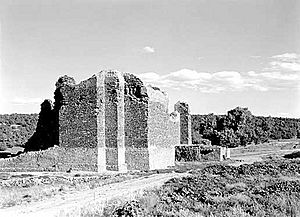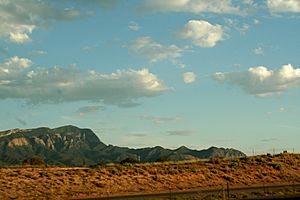Estéban de Perea facts for kids
Quick facts for kids
Estéban de Perea
|
|
|---|---|
| Born |
Villanueva del Fresno, Extremadura, Spain
|
| Died | 1638 or 1639 New Mexico
|
| Nationality | Spanish |
| Occupation | Friar |
| Known for | Missionary activity |
| Parents |
|
Estéban de Perea was a Spanish Franciscan friar. He worked as a missionary in New Mexico between 1610 and 1638. New Mexico was then a part of New Spain. Sometimes, he had disagreements with the governors of the area. He is known as the "Father of the New Mexican Church" because of his important work.
Contents
Who Was Estéban de Perea?
Estéban de Perea was born in Villanueva del Fresno, a town in Extremadura, Spain. This town was close to the border with Portugal. His parents were Portuguese. In 1629, the Church looked into his family history. They wanted to make sure his family was "pure" in their Christian faith. Even though some people said his mother's family might have had Jewish roots, the Franciscans decided to ignore this and let him continue his work.
Starting His Missionary Work
Fray Estéban de Perea arrived in New Mexico in 1610. Soon after, he started a mission called Nuestra Señora de los Dolores (Our Lady of Sorrows) at Sandia Pueblo. This was south of Santa Fe. People in Santa Fe complained that the mission used too much iron, leaving little for others.
Perea also visited the Hopi people. He was very impressed by them. He wrote that they were hardworking and good people with strong houses. He felt their land looked a lot like Spain.
The Church believed its main goal in New Mexico was to convert the Native Americans. The civil government was there to protect and support this goal. But the governor, who was also the chief judge and army head, had his own goals. This often led to conflicts between the Church and the government.
On August 12, 1613, another Franciscan leader, Fray Isidro Ordóñez, arrested Governor Pedro de Peralta. Peralta was chained and held at the Sandía mission. Perea was his jailer. Perea didn't agree with the arrest but followed orders.
Around 1616 or 1617, the Franciscans set up a religious group called the Custodia de la Conversión de San Pablo del Nuevo México. Perea was chosen as its first leader, becoming the head of the Church in New Mexico. From 1618 to 1626, Perea had many arguments with Governor Juan de Eulate. In 1620, the leader of New Spain heard complaints about how Native Americans were being treated. He sent rules to both Perea and Governor Eulate about this.
In 1620, Perea sent a report to Mexico City about the progress of the missions. Because of his report, six more friars were sent to New Mexico in 1621. Perea left his leadership role that year but stayed in New Mexico. The disagreements between the Church and the government became so bad that in 1622, the Franciscans thought about leaving New Mexico. But Perea begged them to stay, and they did.
In 1626, Fray Alonso de Benavides became the new Church leader. He also had special powers from the Inquisition. This made him almost as powerful as the governor. Perea left New Mexico for a short time. Benavides visited all the Native American villages and saw that the friars were doing well in converting people. He asked for more missionaries. King Philip IV of Spain valued New Mexico because of the many souls that could be saved there. So, he ordered thirty more friars to be sent.
Perea's Second Time as Leader
In 1629, Perea came back to New Mexico with about thirty friars and several helpers. They came to continue missionary work. He might have traveled with the new governor, Captain Don Francisco Manuel de Silva Nieto. Perea was a special inspector and the new Church leader, replacing Benavides.
Governor Silva was much more helpful to the friars than previous governors. He supported their work. By the end of 1629, New Mexico had about thirty-five missions. Forty-six friars worked there, serving around 35,000 converted Native Americans.
Perea also brought a letter from the archbishop in Mexico City. This letter was about a Spanish nun named María de Ágreda. She had visions where she said she traveled to a group of people called Jumanos and preached to them. She didn't name the places, but priests in Spain thought it sounded like New Mexico. Around the same time, several Jumano groups came to the New Mexico missions. They said a young woman in blue had visited them and told them to ask for friars. The friars quickly connected these two stories and started looking into it as a possible miracle.
On June 23, 1629, Perea went with Governor Silva on a trip to Zuni. They had thirty soldiers, ten wagons, many horses, and priests. The Zuni people welcomed them, perhaps because of the large group. The soldiers showed great respect to the friars, kneeling and kissing their feet. They told the Zuni people to do the same. Perea felt this welcome meant "God hath already disposed this vineyard." A cross and a large platform were built in the Hawikuh village square. The next day, the Spanish held Mass and baptized many Zuni leaders. Even though things seemed good, Perea noticed that the Zuni people still followed their old beliefs. He wrote that they "have their gods in the mountains, in the rivers, in the harvests, and in their houses."
A house was bought for the friars, which became the first church in the area. Governor Silva helped the Franciscans set up other missions near Zuni. One was at Hawikuh, about 15 miles down the Zuni valley. Another was further west at the Hopi village of Awatobi. Perea and Governor Silva also sent Fray Juan Ramírez with soldiers further west to Ácoma.
The peace with the Zuni people did not last. In February 1632, a Franciscan missionary named Juan Letrado was killed in Zuni, just one week after he arrived. In March 1632, soldiers were sent to Zuni to get revenge for his death.
Perea wrote about some problems during Governor Silva's time. He noted that some white settlers and people of mixed race were superstitious and influenced by Native American customs. He also mentioned that some men were unfaithful to their wives.
Later Years and Legacy

Perea remained the Church leader until 1631. In 1632, he published a book about the missionary work in New Mexico. In 1633, Perea was working as a missionary at Quarai. He wrote that the governor was letting settlers take over land that belonged to both the Native Americans and the mission. He stayed with the Franciscans until he died in New Mexico in 1638 or 1639. He was buried at the mission he had started in Sandía.
Perea believed that people should not be forced to convert. He said, "With suavity and mildness an obstinate spirit can better be reclaimed than with violence and rigor." This means that kindness and gentleness work better than force.
According to a historian named France V. Scholes, Perea was a very important person in the history of the Church in New Mexico. For about thirty years, he was the main leader of religious life there. His many years of service and his strong influence make him a very important figure in New Mexican history, even more so than Benavides. Perea truly deserves to be called the "Father of the New Mexican Church."
es:Esteban de Perea#top
See also
 In Spanish: Esteban de Perea para niños
In Spanish: Esteban de Perea para niños



